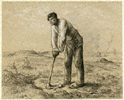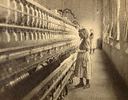
These lessons explore the many ways that art can provoke dialogue about the costs and consequences of significant events in U.S. and world history while simultaneously effecting social change and increasing awareness among individuals and governments.
Beginning-level activities address elementary school standards, intermediate activities address middle school standards, and advanced activities address high school standards. However, middle and high school teachers can use less advanced activities in warm-up discussions or to review basic principles.
|
 |
|
 |
 |
Lessons 19-24 of 24 |
 |
 |
 |
 |
 |

  |
 |
Putting a Spin on Current Events (Beginning Level)
Grades/Level: Lower Elementary (K–2), Upper Elementary (3–5)
Subjects: Visual Arts, History—Social Science
Lesson Overview: Students will analyze art elements and symbolism on a 17th-century cabinet and create cardboard cabinets using symbols to convey a message.
|
 |
 |
 |
Putting a Spin on Current Events (Intermediate Level)
Grades/Level: Middle School (6–8)
Subjects: Visual Arts, History—Social Science
Lesson Overview: Students will examine the influence of Greek and Roman mythology on art, discuss strategies of propaganda in an ancient portrait and a 17th-century cabinet, and create a campaign poster for a classroom candidate that uses Greek or Roman iconography.
|
 |
 |
 |
Putting a Spin on Current Events (Advanced Level)
Grades/Level: High School (9–12)
Subjects: Visual Arts, History—Social Science
Lesson Overview: Students will compare propagandistic strategies in artworks to modern-day examples of persuasive techniques and create a propaganda poster for a current political leader.
|
 |
 |
 |
What Is Work and Who Are the Workers? (Beginning Level)
Grades/Level: Lower Elementary (K–2), Upper Elementary (3–5)
Subjects: Visual Arts, English—Language Arts, History—Social Science
Lesson Overview: Students will analyze depictions of workers in a drawing and two photographs. They will conduct an interview with a family member and create original drawings about work.
|
 |
 |
 |
What Is Work and Who Are the Workers? (Intermediate Level)
Grades/Level: Middle School (6–8)
Subjects: Visual Arts, History—Social Science
Lesson Overview: Students will discuss child labor in the United States as represented in an early-20th-century photograph, research and write a story based on the issue of child labor, and participate in a mock news broadcast in response to the works of art.
|
 |
 |
 |
What Is Work and Who Are the Workers? (Advanced Level)
Grades/Level: High School (9–12)
Subjects: Visual Arts, History—Social Science
Lesson Overview: Students will research labor unions, keep a photographer's journal, and create a photograph of a worker faced with difficult conditions.
|
 |
 |
 |
 |
 |
 |
Lessons 19-24 of 24 |
 |
 |
 |
 |
 |

  |
 |





